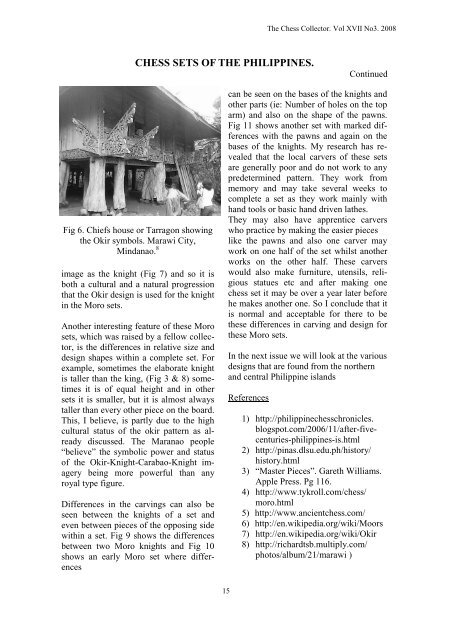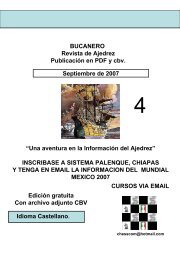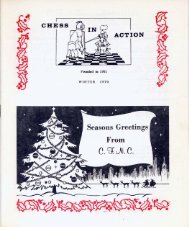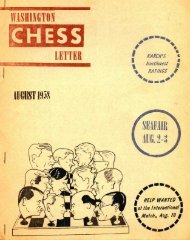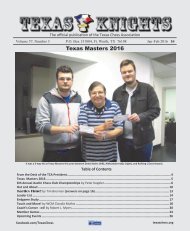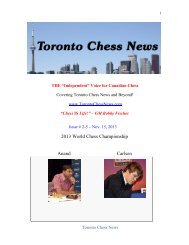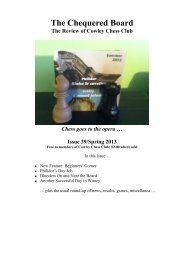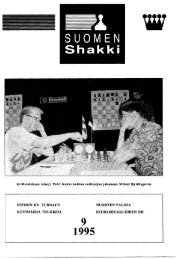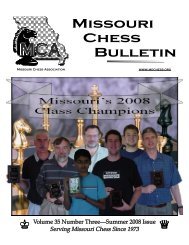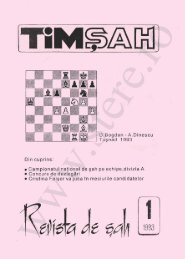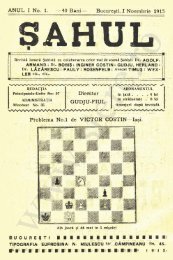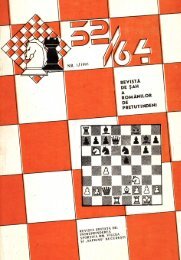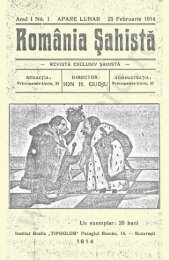The Chess Collector
El ajedrez es un juego, considerado un deporte, entre dos personas, cada una de las cuales dispone de 16 piezas móviles que se colocan sobre un tablero dividido en 64 escaques. En su versión de competición está considerado como un deporte.
El ajedrez es un juego, considerado un deporte, entre dos personas, cada una de las cuales dispone de 16 piezas móviles que se colocan sobre un tablero dividido en 64 escaques. En su versión de competición está considerado como un deporte.
You also want an ePaper? Increase the reach of your titles
YUMPU automatically turns print PDFs into web optimized ePapers that Google loves.
<strong>The</strong> <strong>Chess</strong> <strong>Collector</strong>. Vol XVII No3. 2008<br />
CHESS SETS OF THE PHILIPPINES.<br />
Continued<br />
Fig 6. Chiefs house or Tarragon showing<br />
the Okir symbols. Marawi City,<br />
Mindanao. 8<br />
image as the knight (Fig 7) and so it is<br />
both a cultural and a natural progression<br />
that the Okir design is used for the knight<br />
in the Moro sets.<br />
Another interesting feature of these Moro<br />
sets, which was raised by a fellow collector,<br />
is the differences in relative size and<br />
design shapes within a complete set. For<br />
example, sometimes the elaborate knight<br />
is taller than the king, (Fig 3 & 8) sometimes<br />
it is of equal height and in other<br />
sets it is smaller, but it is almost always<br />
taller than every other piece on the board.<br />
This, I believe, is partly due to the high<br />
cultural status of the okir pattern as already<br />
discussed. <strong>The</strong> Maranao people<br />
“believe” the symbolic power and status<br />
of the Okir-Knight-Carabao-Knight imagery<br />
being more powerful than any<br />
royal type figure.<br />
Differences in the carvings can also be<br />
seen between the knights of a set and<br />
even between pieces of the opposing side<br />
within a set. Fig 9 shows the differences<br />
between two Moro knights and Fig 10<br />
shows an early Moro set where differences<br />
can be seen on the bases of the knights and<br />
other parts (ie: Number of holes on the top<br />
arm) and also on the shape of the pawns.<br />
Fig 11 shows another set with marked differences<br />
with the pawns and again on the<br />
bases of the knights. My research has revealed<br />
that the local carvers of these sets<br />
are generally poor and do not work to any<br />
predetermined pattern. <strong>The</strong>y work from<br />
memory and may take several weeks to<br />
complete a set as they work mainly with<br />
hand tools or basic hand driven lathes.<br />
<strong>The</strong>y may also have apprentice carvers<br />
who practice by making the easier pieces<br />
like the pawns and also one carver may<br />
work on one half of the set whilst another<br />
works on the other half. <strong>The</strong>se carvers<br />
would also make furniture, utensils, religious<br />
statues etc and after making one<br />
chess set it may be over a year later before<br />
he makes another one. So I conclude that it<br />
is normal and acceptable for there to be<br />
these differences in carving and design for<br />
these Moro sets.<br />
In the next issue we will look at the various<br />
designs that are found from the northern<br />
and central Philippine islands<br />
References<br />
1) http://philippinechesschronicles.<br />
blogspot.com/2006/11/after-fivecenturies-philippines-is.html<br />
2) http://pinas.dlsu.edu.ph/history/<br />
history.html<br />
3) “Master Pieces”. Gareth Williams.<br />
Apple Press. Pg 116.<br />
4) http://www.tykroll.com/chess/<br />
moro.html<br />
5) http://www.ancientchess.com/<br />
6) http://en.wikipedia.org/wiki/Moors<br />
7) http://en.wikipedia.org/wiki/Okir<br />
8) http://richardtsb.multiply.com/<br />
photos/album/21/marawi )<br />
15


